Removal of Tetracycline Hydrochloride by Photocatalysis Using Electrospun PAN Nanofibrous Membranes Coated with g-C3N4/Ti3C2/Ag3PO4
Abstract
1. Introduction
2. Results and Discussion
2.1. Analysis of FTIR
2.2. Analysis of X-ray Diffractometer
2.3. Analysis of UV-Vis Diffuse Reflectance Spectra (DRS)
2.4. Analysis of Zeta Potential
2.5. Morphology Analysis
2.6. Photocatalytic Performance of Nanofiber Photocatalysis Film
2.7. Photocatalytic Mechanism
3. Materials and Methods
3.1. Materials
3.2. Synthesis of Catalyst
3.3. Characterization
3.4. Photocatalytic Activity
4. Conclusions
Author Contributions
Funding
Institutional Review Board Statement
Informed Consent Statement
Data Availability Statement
Conflicts of Interest
Sample Availability
References
- McClelland, S.; Lamoureux, B.; Larson, E. Trends in Antimicrobial Resistance Legislation 2011–2019: A Review of the US Policy Response to the Antimicrobial Resistance Threat and its Public Health Impact. Am. J. Infect. Control 2021, 46, 813–817. [Google Scholar] [CrossRef]
- Cai, T.; Wang, L.; Liu, Y.; Zhang, S.; Dong, W.; Chen, H.; Yi, X.; Yuan, J.; Xia, X.; Liu, C.; et al. Ag3PO4/Ti3C2 MXene Interface Materials as a Schottky Catalyst with Enhanced Photocatalytic Activities and Anti-photocorrosion Performance. Appl. Catal. B Environ. 2018, 239, 545–554. [Google Scholar] [CrossRef]
- Ma, D.; Liu, W.; Chen, Q.; Jin, Z.; Zhang, Y.; Huang, J.; Zhang, H.; Peng, F.; Luo, T. Titanium-oxo-clusters Precursors for Preparation of In2S3/TiO2 Heterostructure and Its Photocatalytic Degradation of Tetracycline In Water. J. Solid State Chem. 2021, 293, 121791. [Google Scholar] [CrossRef]
- Chen, C.; Zeng, H.; Yi, M.; Xiao, G.; Xu, S.; Shen, S.; Feng, B. In-situ Growth of Ag3PO4 on Calcined Zn-Al Layered Double Hydroxides for Enhanced Photocatalytic Degradation of Tetracycline Under Simulated Solar Light Irradiation and Toxicity Assessment. Appl. Catal. B Environ. 2019, 252, 47–54. [Google Scholar] [CrossRef]
- Yuan, L.; Geng, Z.; Zhang, S.; Xu, J.; Guo, F.; Kumar Kundu, B.; Han, C. Efficient All-in-one Removal of Total Chromium Over Nonconjugated Polymer-inorganic ZnIn2S4 Semiconductor Hybrid. J. Colloid Interface Sci. 2022, 628 Pt A, 100–108. [Google Scholar] [CrossRef] [PubMed]
- Kundu, B.K.; Han, G.; Sun, Y. Derivatized Benzothiazoles as Two-Photon-Absorbing Organic Photosensitizers Active under Near Infrared Light Irradiation. J. Am. Chem. Soc. 2023, 145, 3535–3542. [Google Scholar] [CrossRef] [PubMed]
- Wang, X.; Maeda, K.; Thomas, A.; Takanabe, K.; Xin, G.; Carlsson, J.M.; Domen, K.; Antonietti, M. A Metal-free Polymeric Photocatalyst for Hydrogen Production from Water Under Visible Light. Nat. Mater. 2009, 8, 76–80. [Google Scholar] [CrossRef] [PubMed]
- Jiang, L.; Yuan, X.; Zeng, G.; Wu, Z.; Liang, J.; Chen, X.; Leng, L.; Wang, H.; Wang, H. Metal-free Efficient Photocatalyst for Stable Visible-light Photocatalytic Degradation of Refractory Pollutant. Appl. Catal. B Environ. 2018, 221, 715–725. [Google Scholar] [CrossRef]
- Jia, J.; Huang, W.; Feng, C.; Zhang, Z.; Zuojiao, K.; Liu, J.; Jiang, C.; Wang, Y. Fabrication of g-C3N4/Ag3PO4-H2O2 Heterojunction System with Enhanced Visible-light Photocatalytic Activity and Mechanism Insight. J. Alloy. Compd. 2019, 790, 616–625. [Google Scholar] [CrossRef]
- Che, Y.; Liu, Q.; Lu, B.; Zhai, J.; Wang, K.; Liu, Z. Plasmonic Ternary Hybrid Photocatalyst Based on Polymeric g-C3N4 Towards Visible Light Hydrogen Generation. Sci. Rep. 2020, 10, 721. [Google Scholar] [CrossRef]
- Zhang, J.; Zhang, M.; Lin, S.; Fu, X.; Wang, X. Molecular Doping of Carbon Nitride Photocatalysts with Tunable Bandgap and Enhanced Activity. J. Catal. 2014, 310, 24–30. [Google Scholar] [CrossRef]
- Zheng, Y.; Lin, L.; Wang, B.; Wang, X. Graphitic Carbon Nitride Polymers toward Sustainable Photoredox Catalysis. Angew. Chem. -Int. Ed. 2015, 54, 12868–12884. [Google Scholar] [CrossRef] [PubMed]
- Patnaik, S.; Martha, S.; Acharya, S.; Parida, K.M. An Overview of the Modification of g-C3N4 with High Carbon Containing Materials for Photocatalytic Applications. Inorg. Chem. Front. 2016, 3, 336–347. [Google Scholar] [CrossRef]
- Wu, C.; Xue, S.; Qin, Z.; Nazari, M.; Yang, G.; Yue, S.; Tong, T.; Ghasemi, H.; Hernandez, F.C.R.; Xue, S.; et al. Making g-C3N4 Ultra-thin Nanosheets Active for Photocatalytic Overall Water Splitting. Appl. Catal. B Environ. 2021, 282, 119557. [Google Scholar] [CrossRef]
- Geng, Y.; Chen, D.; Li, N.; Xu, Q.; Li, H.; He, J.; Lu, J. Z-Scheme 2D/2D α-Fe2O3/g-C3N4 Heterojunction for Photocatalytic Oxidation of Nitric Oxide. Appl. Catal. B Environ. 2021, 280, 119409. [Google Scholar] [CrossRef]
- Fu, N.; Jin, Z.; Wu, Y.; Lu, G.; Li, D. Z-Scheme Photocatalytic System Utilizing Separate Reaction Centers by Directional Movement of Electrons. J. Phys. Chem. C 2011, 115, 8586–8593. [Google Scholar] [CrossRef]
- Peng, J.; Chen, X.; Ong, W.-J.; Zhao, X.; Li, N. Surface and Heterointerface Engineering of 2D MXenes and Their Nanocomposites: Insights into Electro- and Photocatalysis. Chem 2019, 5, 18–50. [Google Scholar] [CrossRef]
- Chen, S.; Lu, W.; Han, J.; Zhong, H.; Xu, T.; Wang, G.; Chen, W. Robust Three-dimensional g-C3N4@cellulose Aerogel Enhanced by Cross-linked Polyester Fibers for Simultaneous Removal of Hexavalent Chromium and Antibiotics. Chem. Eng. J. 2019, 359, 119–129. [Google Scholar] [CrossRef]
- Qin, D.; Lu, W.; Wang, X.; Li, N.; Chen, X.; Zhu, Z.; Chen, W. Graphitic Carbon Nitride from Burial to Re-emergence on Polyethylene Terephthalate Nanofibers as an Easily Recycled Photocatalyst for Degrading Antibiotics under Solar Irradiation. ACS Appl. Mater. Interfaces 2016, 8, 25962–25970. [Google Scholar] [CrossRef]
- Yu, Y.; Bu, Y.; Zhong, Q.; Cai, W. Catalytic Oxidation of NO by g-C3N4-assisted Electrospun Porous Carbon Nanofibers at Room Temperature: Structure-activity Relationship and Mechanism Study. Catal. Commun. 2016, 87, 62–65. [Google Scholar] [CrossRef]
- Xu, Q.; Wang, P.; Wang, Z.; Shen, J.; Han, X.; Zheng, X.; Wei, Y.; Li, C.; Song, K. Aerosol Self-assembly Synthesis of g-C3N4/MXene/Ag3PO4 Heterostructure for Enhanced Photocatalytic Degradation of Tetracycline Hydrochloride. Colloids Surf. A: Physicochem. Eng. Asp. 2022, 648, 129392. [Google Scholar] [CrossRef]
- Shi, Y.; Li, J.; Wan, D.; Huang, J.; Liu, Y. Peroxymonosulfate-enhanced Photocatalysis by Carbonyl-modified g-C3N4 for Effective Degradation of the Tetracycline Hydrochloride. Sci. Total Environ. 2020, 749, 142313. [Google Scholar] [CrossRef] [PubMed]
- Kundu, B.K.; Das, M.; Ganguly, R.; Bhobe, P.A.; Mukhopadhyay, S. Role of Zeolite Encapsulated Cu(II) Complexes in Electron Transfer as Well as Peroxy Radical Intermediates Formation During Oxidation of Thioanisole. J. Catal. 2020, 389, 305–316. [Google Scholar] [CrossRef]
- Yu, H.; Wang, D.; Zhao, B.; Lu, Y.; Wang, X.; Zhu, S.; Qin, W.; Huo, M. Enhanced Photocatalytic Degradation of Tetracycline Under Visible Light by Using a Ternary Photocatalyst of Ag3PO4/AgBr/g-C3N4 with Dual Z-scheme Heterojunction. Sep. Purif. Technol. 2020, 237, 116365. [Google Scholar] [CrossRef]
- Jiang, L.; Yuan, X.; Zeng, G.; Liang, J.; Chen, X.; Yu, H.; Wang, H.; Wu, Z.; Zhang, J.; Xiong, T. In-situ Synthesis of Direct Solid-state Dual Z-scheme WO3/g-C3N4/Bi2O3 Photocatalyst for the Degradation of Refractory Pollutant. Appl. Catal. B Environ. 2018, 227, 376–385. [Google Scholar] [CrossRef]
- Ding, X.; Li, C.; Wang, L.; Feng, L.; Han, D.; Wang, W. Fabrication of hierarchical g-C3N4/MXene-AgNPs Nanocomposites with Enhanced Photocatalytic Performances. Mater. Lett. 2019, 247, 174–177. [Google Scholar] [CrossRef]
- Li, F.; Dong, Y.; Kang, W.; Cheng, B.; Cui, G. Enhanced Removal of Azo Dye Using Modified PAN Nanofibrous Membrane Fe Complexes with Adsorption/Visible-driven Photocatalysis Bifunctional Roles. Appl. Surf. Sci. 2017, 404, 206–215. [Google Scholar] [CrossRef]
- Patel, S.; Konar, M.; Sahoo, H.; Hota, G. Surface Functionalization of Electrospun PAN Nanofibers with ZnO-Ag Heterostructure Nanoparticles: Synthesis and Antibacterial Study. Nanotechnology 2019, 30, 205704. [Google Scholar] [CrossRef]


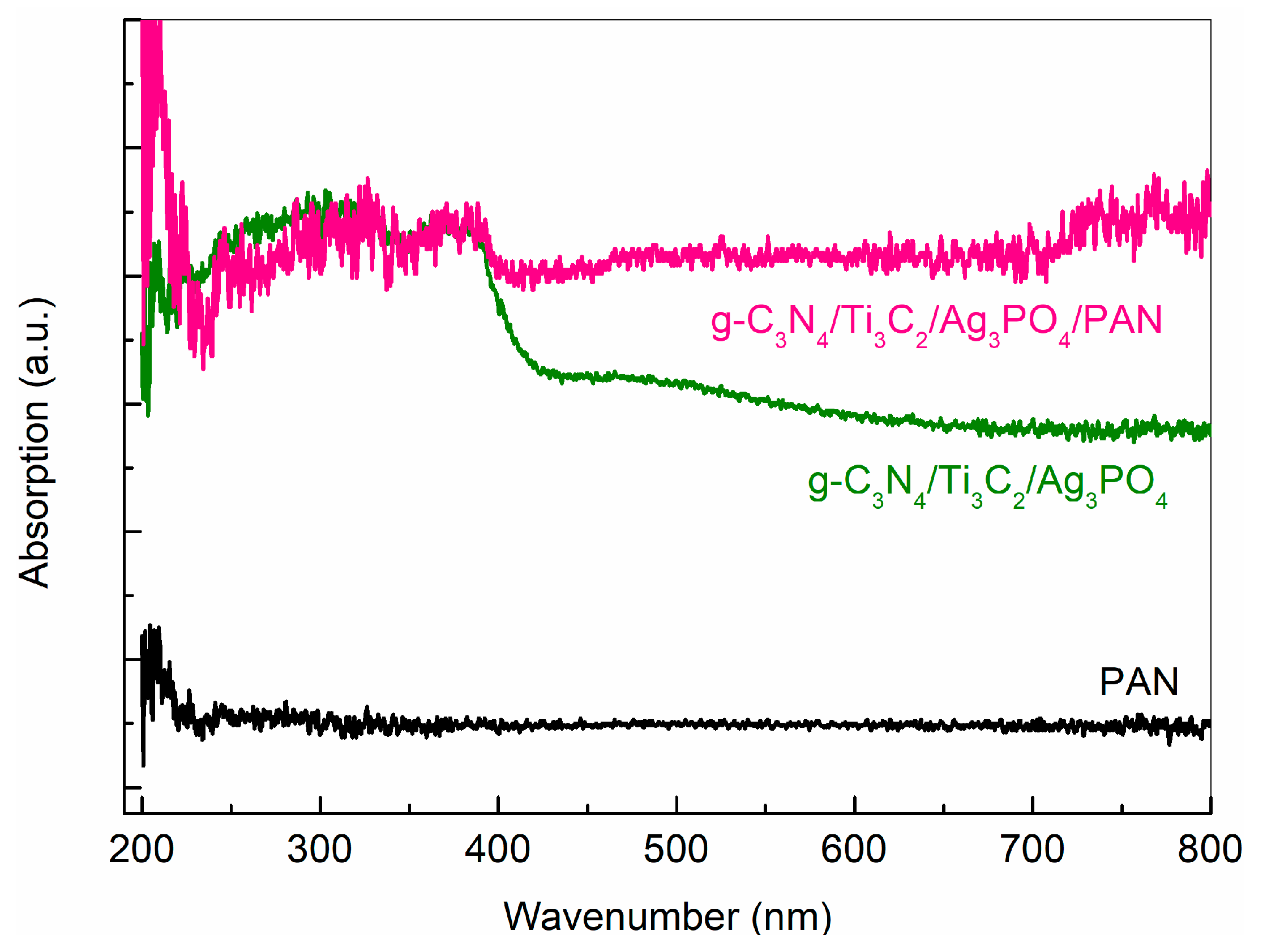
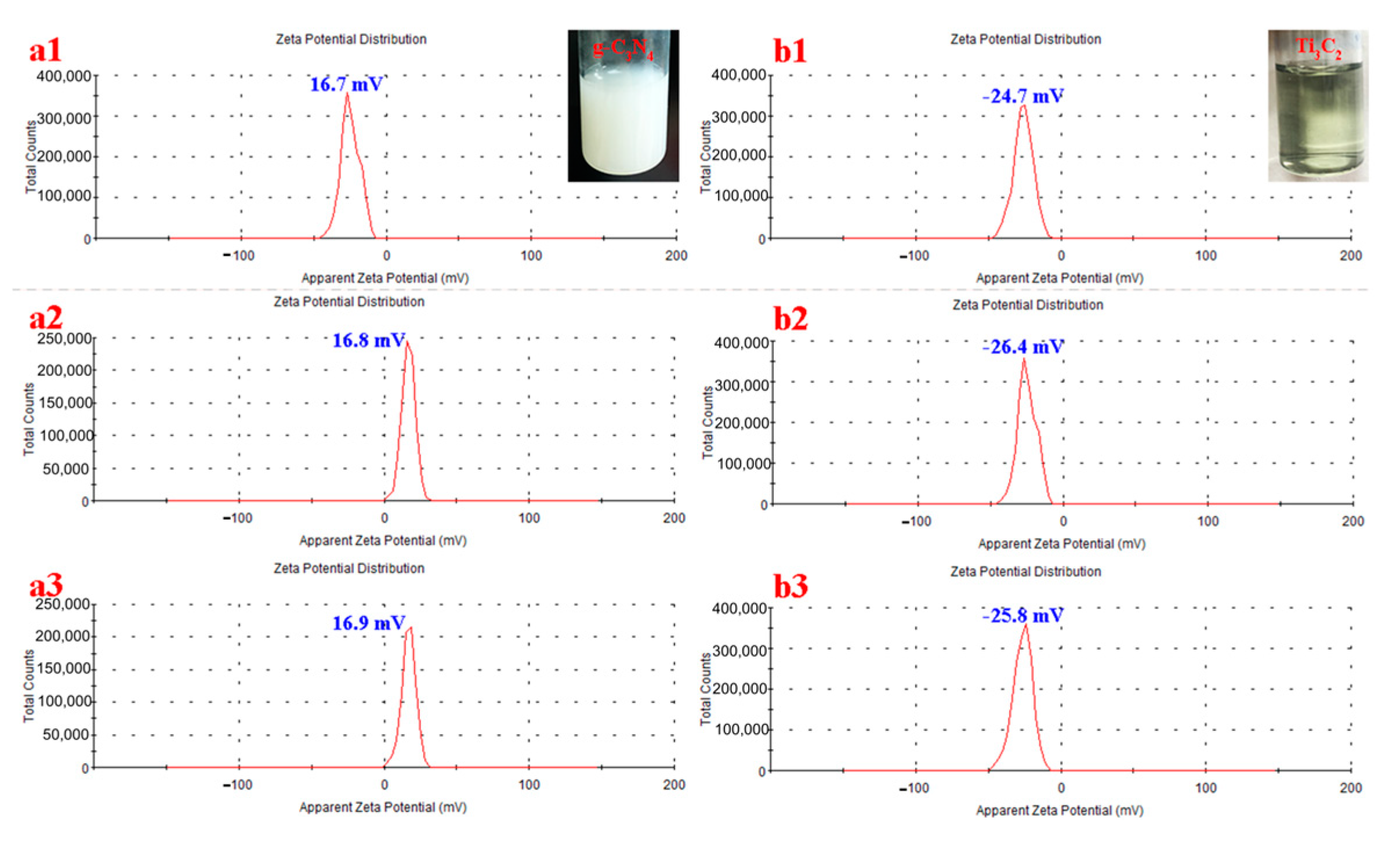


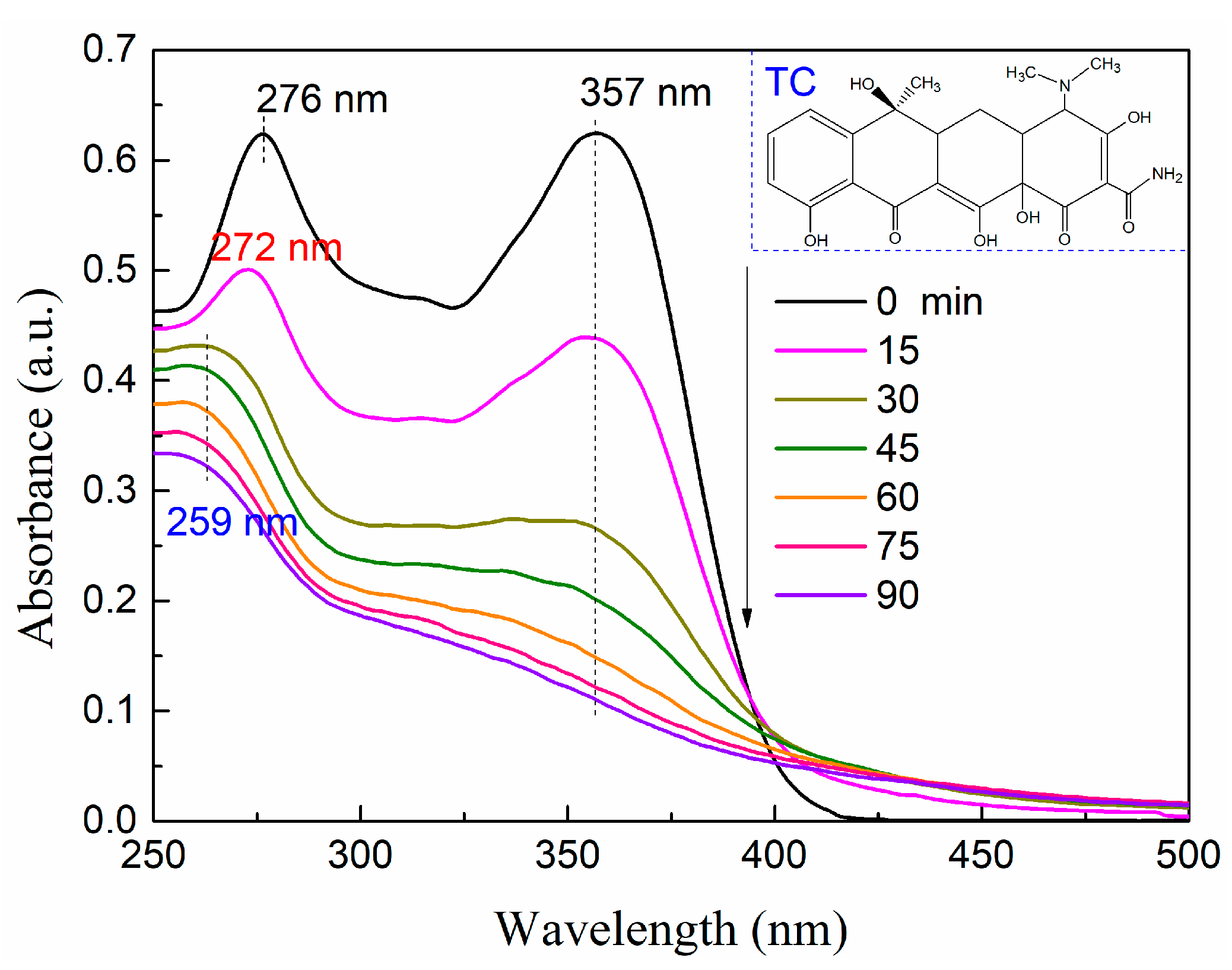
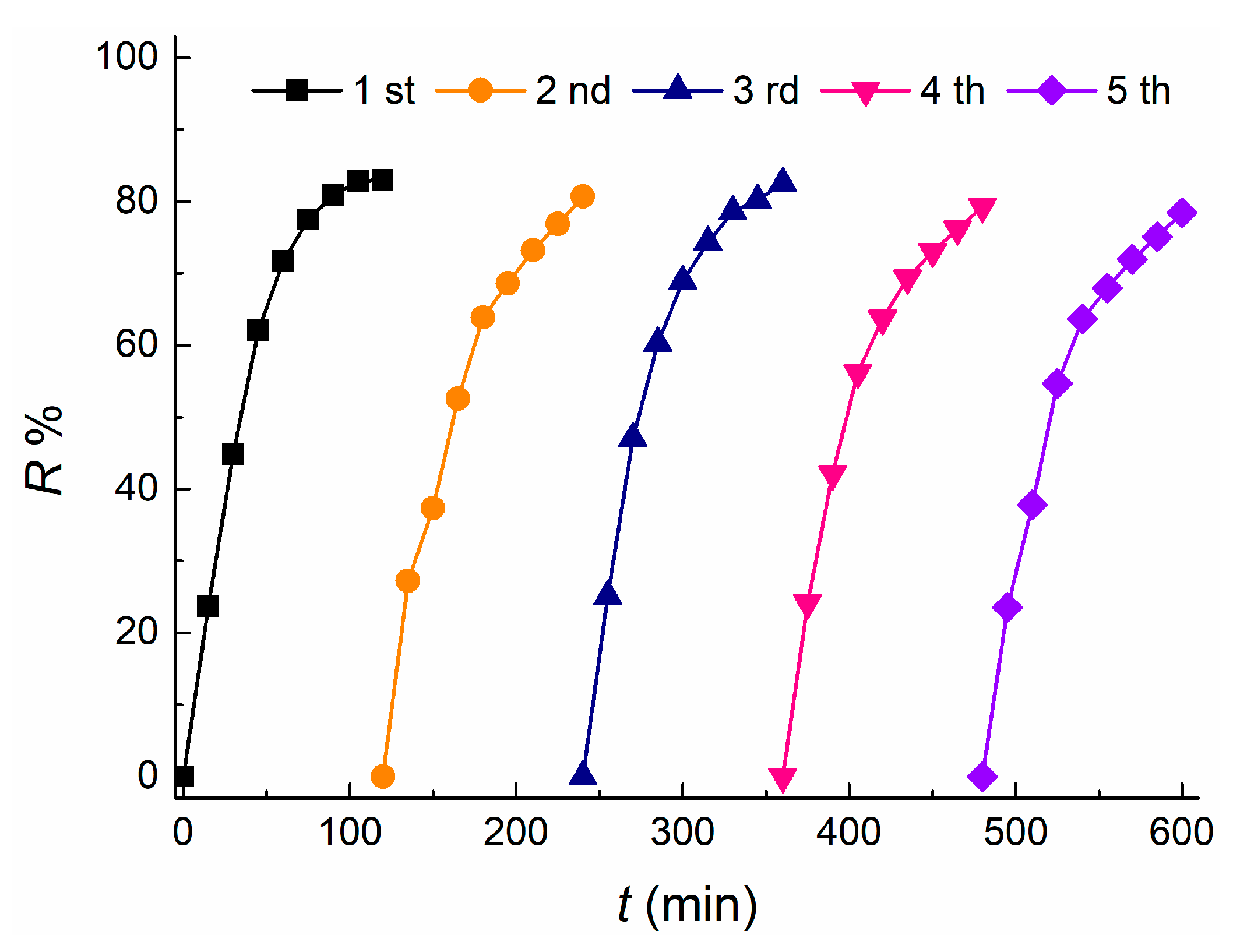

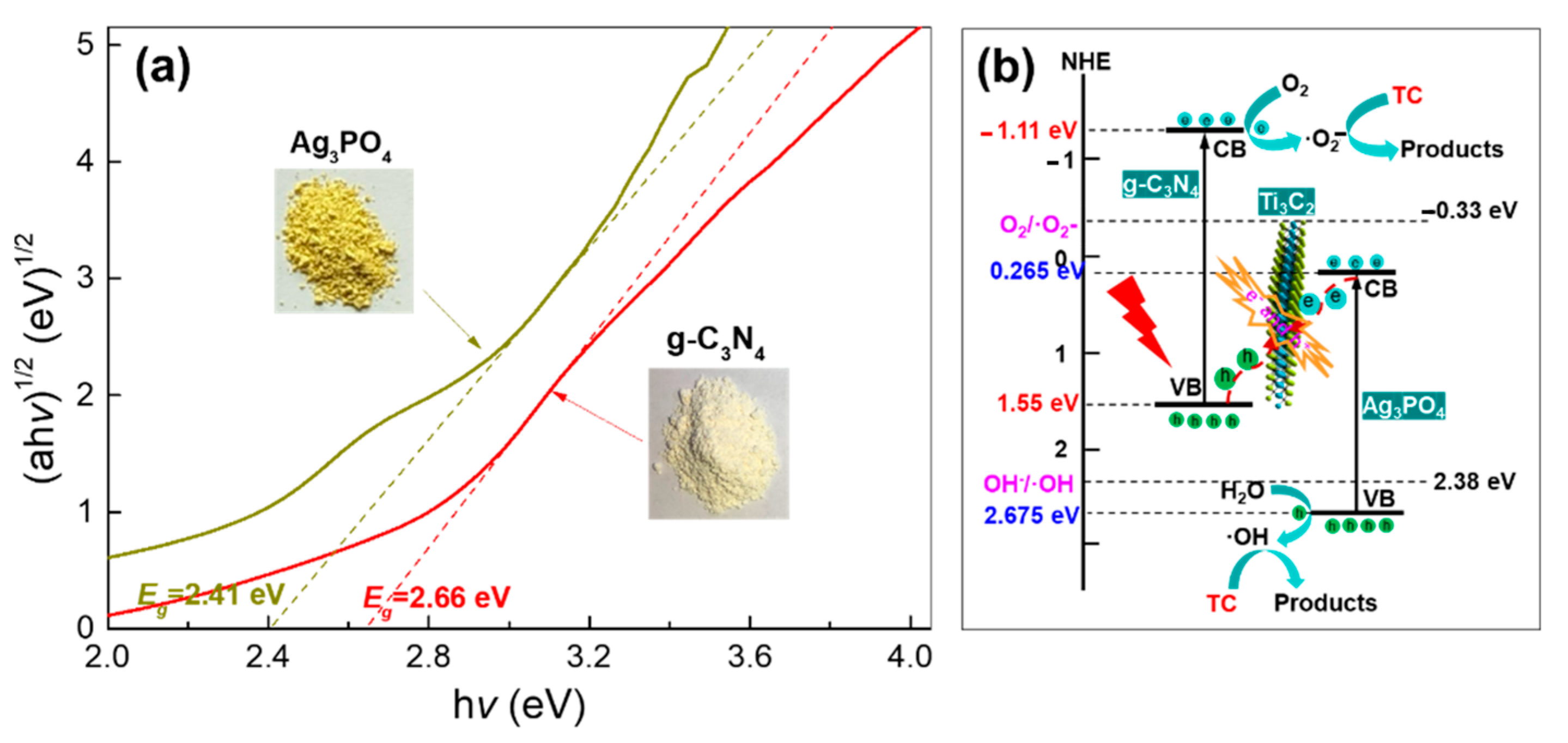
Disclaimer/Publisher’s Note: The statements, opinions and data contained in all publications are solely those of the individual author(s) and contributor(s) and not of MDPI and/or the editor(s). MDPI and/or the editor(s) disclaim responsibility for any injury to people or property resulting from any ideas, methods, instructions or products referred to in the content. |
© 2023 by the authors. Licensee MDPI, Basel, Switzerland. This article is an open access article distributed under the terms and conditions of the Creative Commons Attribution (CC BY) license (https://creativecommons.org/licenses/by/4.0/).
Share and Cite
Wang, P.; Han, X.; Zheng, X.; Wang, Z.; Li, C.; Zhao, Z. Removal of Tetracycline Hydrochloride by Photocatalysis Using Electrospun PAN Nanofibrous Membranes Coated with g-C3N4/Ti3C2/Ag3PO4. Molecules 2023, 28, 2647. https://doi.org/10.3390/molecules28062647
Wang P, Han X, Zheng X, Wang Z, Li C, Zhao Z. Removal of Tetracycline Hydrochloride by Photocatalysis Using Electrospun PAN Nanofibrous Membranes Coated with g-C3N4/Ti3C2/Ag3PO4. Molecules. 2023; 28(6):2647. https://doi.org/10.3390/molecules28062647
Chicago/Turabian StyleWang, Peng, Xu Han, Xianhong Zheng, Zongqian Wang, Changlong Li, and Zhiqi Zhao. 2023. "Removal of Tetracycline Hydrochloride by Photocatalysis Using Electrospun PAN Nanofibrous Membranes Coated with g-C3N4/Ti3C2/Ag3PO4" Molecules 28, no. 6: 2647. https://doi.org/10.3390/molecules28062647
APA StyleWang, P., Han, X., Zheng, X., Wang, Z., Li, C., & Zhao, Z. (2023). Removal of Tetracycline Hydrochloride by Photocatalysis Using Electrospun PAN Nanofibrous Membranes Coated with g-C3N4/Ti3C2/Ag3PO4. Molecules, 28(6), 2647. https://doi.org/10.3390/molecules28062647





